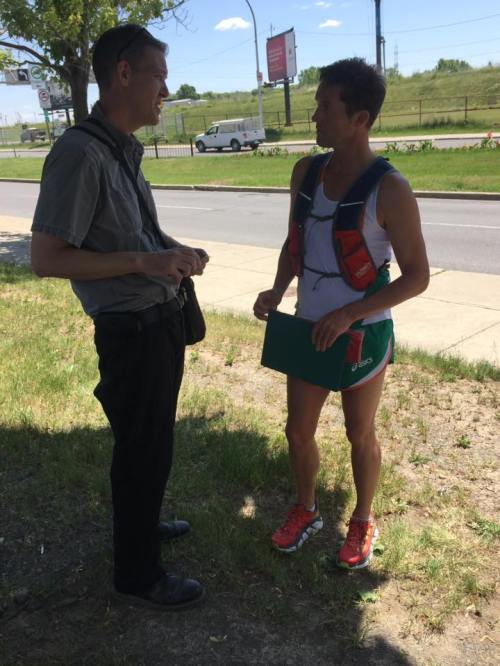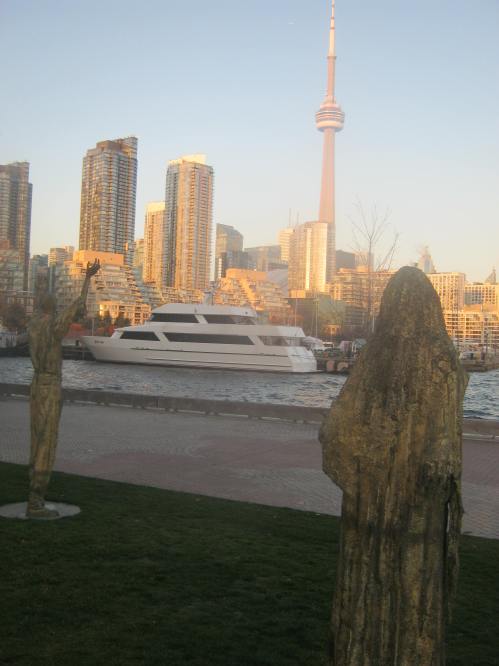The most striking fact that emerged from the research I conducted on the passage of some 100,000 who left Ireland aboard the infamous coffin ships in the spring of 1847 was how the municipal authorities, in tandem with the religious orders of Montreal, marshaled their collective resources to care and minister to the sick and dying Irish.
Simply put, the question was: What affinity did the native Québecois have toward this advance of typhus-stricken Irish?
The facts are sobering. Disease and death loomed with the advance of the Irish along the Saint Lawrence. By early June, a month after the official seasonal opening of the quarantine station at Grosse Île, forty ships, each carrying over 300 passengers, were lined back along the Saint Lawrence. The quarantine island medical facilities, which had been built to accommodate just 200 sick, was simply overrun. No true medical assessment of individual cases could be adequately determined.
Only the obviously dying were taken to the fever sheds. In effect, the île would become less a quarantine station and more a graveyard. In that season of death, upward of 5,000 souls would be hastily interred in trenched mass graves.
And so it went – as an apocalyptic, zombie-like advance of 75,000, typhus stricken Irish headed toward Montreal, then a city of 50,000. The heroics of those who met the advance of sickness bears testimony to one of the most harrowing stories of the Great Hunger.
Again, in assessing the massive influx of immigrants, one is left asking, what was the resolve of Montreal to bear and minister to such an alien-speaking flotsam of Irish?
In a slow advance toward Montreal, much that is asked in that question is becoming apparent. I chose Route 2 for the run, given that it languidly follows the meandering Saint Lawrence, but, in now running alongside this less-traveled road, I come upon religious shrines that harken to a penitent spectre of a more ancient, religious life. This is an ancient road of agrarian toil, a trail worn by a dutiful and faithful peasantry. Within two days of leaving Quebec City, I had run in the domain of a forgotten Catholicism in a rural foothold of former peasant lands.

Michael Collins at churches along the Saint Lawrence in Quebec. Photograph: Anne Petersen
The religious shrines are eerily reminiscent of those that still exist along the coastal crag of the West of Ireland; weathered figures of Christ’s passion on a cross facing the eternal scour of the Atlantic gales. You expect this of Ireland, but to come upon these roadside shrines in the rainy cold is a revelation.

Photograph: Anne Petersen
The agony of the cross proves to be the most enduring and arresting subjects out on the peninsula beyond Quebec City. Though peculiar to the French Canadians, the statuettes bear the mediaeval flourish of a golden painted adornment with the azure blue of Mary’s robes.
On the evening of the fifth day of the run – my fifth consecutive marathon – while fighting advancing dark, I came across a small acreage of a farm with a roadside glass enclosure of Joseph holding the infant Jesus. It might as well have been an apparition. We are so given to movement and flash, to the blare of sound, that coming upon this serenity, locking eyes on the paternal vigil of father and son, reawakened a religious supplication that I had not felt since being a boarder at Saint Munchin’s school in Limerick. Here was the quiet communion and intercession of a deep-felt religiosity made incarnate.
In the solitary pilgrimage of miles, I was connected with the beatitude of those saintly figures who heard God or Mary speak to them on hillsides. Nature and solitude are together a powerful elixir. In our apparent smallness, in apprehending the glory of the seasons, we instinctively submit to honouring a higher power.

Photograph: Anne Petersen
By a crude calculation of observation, I established that most of the shrines were some ten miles apart, and thus I had landed upon a measure of time and distance that was linked to an older mode of travel – walking. Here were shrines established at a natural respite between distances, shrines appointed along the protective bend in the river, altars recessed at an angle in a conjuring so they might refract light and divine some moment of revelation for the weary traveller.
Power of salvation
I ran over 300km in the first six days after leaving Grosse Île, and, in so doing, in taking this less traveled passage along the Saint Lawrence, I began to answer the question regarding why so many of Montreal’s secular and religious community felt the compunction to risk their lives to save the Irish.
The most arresting early reading I did on the passage to Canada in 1847 centered on the role of the Grey Nuns, who ministered to the newly arrived immigrants. By the hand of providence – and I do believe that some projects are guided by divine intervention – I uncovered that the first-of-its-kind exhibition of the Grey Nuns was about to end its run at Quinnipiac University in Connecticut.


The exhibition was curated by one of Ireland’s great Irish Famine historians, Dr Christine Kinealy. After making contact with Dr Kinealy, she graciously agreed to keep the exhibition up for an extra day so I could come visit.

Dr. Jason King, Professor Christine Kinealy, and Canadian Ambassador Kevin Vickers at launch of Digital Irish Famine Archive.
On a last-minute plane to Connecticut, I had read the annals of the Grey Nuns, collated by the esteemed scholar, Dr Jason King. The work is nothing short of genius, and, though I can’t attest to the power of the French text, the translation by Philip O’Gorman is one of those revelatory academic works that bridges facts with a tonal acuity that captures the essential psyche of the order:
http://faminearchive.nuigalway.ie/

Click to access TheTyphusof1847.pdf
Through the act of reading, I understood the motivation and sacrifice of the order of Grey Nuns. I was immediately and shamefully reminded of my own fallen state, of how I had a great-aunt, who, in the cloister of over 75 years as a nun, had served the poor and indigent as a member of the order of The Little Sisters of the Poor.
On the eve of St Patrick’s Day, and with the exodus of the student body for Spring Break, I arrived onto an eerily depopulated, bucolic campus. The encounter with Dr Kinealy figures as one of those deeply affecting preordained moments – firstly for the graciousness of Dr Kinealy in agreeing to host me, but also for the religious aura she captured in curating the exhibition. In a contained, single room, she brought the events of 1847 into a singular, spiritual experience. This was scholarship wedded to a deeply affecting understanding of the spirituality of the order of Grey Nuns.
The Grey Nuns, those so-called Martyrs of Charity, were the first to the hastily erected fever sheds on the outskirts of Montreal’s harbor at Pointe St Charles. In the translated texts there is a spirituality communicated that reveals, dare I say it, an ancient, seductive power of a sort of spiritual ecstasy that pits the temporality of earthly life against an eternal reward with Christ.


Maps of Montreal Fever Sheds.
In arriving at Quinnipiac University and then eventually standing outside the Grey Nuns’ Convent in Montreal, I better understood the redeeming power of salvation and the charged humanity of earthly acts performed while one’s heart is directed heavenward. This was the greater reality of life in the pre-enlightenment – harsh brutish and short.
There are descriptions of sickness and effluence referenced in the fever sheds that sickened veteran doctors, and yet the chronicles of the annals report that the Martyrs of Charity actively sought out the most distressing cases of disease. A seasoned doctor, a Protestant who worked in the fever sheds, reportedly converted to Catholicism on his deathbed, requesting that the sisters tend to him.

Theophile Hamel’s Le Typhus (1847-48) with Grey Nuns in the foreground.
In reading the annals, what is transmitted is an authenticity of reportage that is so deeply affecting that one feels as though one is bearing witness to a faith that was first eclipsed by an Enlightenment age of reason and science, which eventually gave way to jaded cynicism.
Click to access TheTyphusof1847.pdf
Arriving at the Black Rock
The first week is done now – the total distance is 300 kilometres, but, more significantly than the kilometres run, I have come across signaling markers and points of introspection that are leading me to a greater context of the relationship of the self to God.
The week ended with my arrival at the Black Rock, a memorial stone that sits in the middle of a traffic island in Montreal. Over 6,000 Irish are interred in a mass grave. All died in the fever sheds. The burial site was uncovered during construction in 1859 of the Victoria Bridge. The historical moment of the fever sheds and the associated burial of so many was almost lost. Stubbornly, the workers who unearthed the entombed erected, at their own cost, the stone that now commemorates those almost forgotten dead.
The Black Rock was my first point of historical significance after leaving Grosse Île. I took the memory of 6,000 souls with me. I linked their memory with those who eventually died further along the Saint Lawrence in the fever sheds at Montreal. This is our Celtic Trail of Tears.

As an Irish expatriate, I am removed from the day-to-day life of a modern Ireland, and yet at times it takes the voice of the pining diaspora to reckon with history. If we can be charged with an arrested sense of history, then so be it. What I can report to you is that in standing at the memorial service held on the occasion of my arrival into Montreal, I was cognizant that this was the end for so many Irish, but also the beginning of the Irish diaspora experience in Canada.
On the day of my arrival, we gathered to honour the dead, but also to celebrate the Canadian Irish experience. On hand were local and national media, as the distinguished parliamentarian Marc Miller, who graciously attended the ceremony, added his support to a plan to move the Black Rock to a proposed famine memorial park.

The memorial park is too long in the waiting. There are the cynics who will say to let the dead lie where they will. It is, of course, the easier of choices, but what I have experienced on this run is a cadre of historically minded, hard-headed citizens who believe remembrance is not connected with advancing animosities, but simply preserving the historical reality of a year so many would prefer to forget.
I cannot end without acknowledging the head of the Ancient Order of Hibernia, Victor Boyle, along with Donovan King, brother of Dr Jason King. Their eloquence and commitment to our history is exemplary. Last but not least, I would like to thank Fergus Keyes and Peggie Hopkins for first greeting me in Quebec City, accompanying me out to Grosse Île and then coordinating the event at the Black Rock.



What I have come to understand is that the preservation of our history does not simply happen. For every monument and statue we casually pass by, there’s a Fergus Keyes who has tirelessly advocated for its place in the competing histories of each city and nation.
How to join the Irish Diaspora Run
The route begins at Grosse Île quarantine island, on the St Lawrence river, and continues through Quebec City, Montreal and Kingston before reaching Ireland Park, in Toronto on July 10th.
The project is raising funds for Irish-Canadian organisations seeking to create parks and erect monuments and statues to commemorate 1847.
Others can participate by taking on runs where they live, and logging their distances on diasporarun.org, where they can also sponsor Collins.
This project is supported by the Global Irish Media Fund


 The second day’s run begins under dark skies for Michael Collins. Photograph: Anne Petersen
The second day’s run begins under dark skies for Michael Collins. Photograph: Anne Petersen The Black Rock in Montreal marks the burial site of 6,000 Irish who died in 1848. Photograph: Kevin Wright/Bloomsday Montreal
The Black Rock in Montreal marks the burial site of 6,000 Irish who died in 1848. Photograph: Kevin Wright/Bloomsday Montreal





















































 Pole star: ultrarunner Michael Collins in the Arctic
Pole star: ultrarunner Michael Collins in the Arctic Famine memorial: Toronto from Ireland Park. Photograph: David Cooper/Toronto Star via Getty
Famine memorial: Toronto from Ireland Park. Photograph: David Cooper/Toronto Star via Getty






